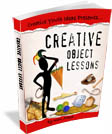In Christ’s teaching, He used the things with which the people were most familiar, the things of the earth to teach them the things that were unfamiliar, the things of heaven. The unknown was illustrated by the known; divine truths by earthly things, the spiritual by the natural, the difficult by the simple. Object lessons speak to the eyes and other senses so that they are received into the heart. In fact, the more senses that are involved, the greater the learning that takes place.
When we use tangible objects – insects, fruits, vegetables, animals, coins, thermometers, tools, and weapons – to teach intellectual and spiritual truths the the teaching method is usually called an object lesson. Something physical is used as a metaphor for an abstract concept or principle that is difficult to explain.
More than just a visual, an object lesson draws a truth from something you are showing or doing. The object becomes a hook on which you hang your lesson and can create powerful associations that serve as reminders every time the object is seen outside the classroom. Real objects, places and events can make learning come alive for children, youth, and adults.
Jesus often used the objects at hand around Him to teach people about God and His Kingdom. When He was by a well, He used water. After He fed 5000 people, He taught them about the Bread of Life. When He was on a fishing boat, He said the Kingdom was like a fishing net. He told His listeners to consider the lilies, the sparrows, and the hairs on their head. Jesus referred to a fig tree, a mustard tree, yeast, salt, a vineyard, money and other things from everyday life to reveal spiritual truth. When He spoke of a vineyard, He was probably by a vineyard. When He said, consider the sparrows, there were probably sparrows flying around. When He taught the parable of the sower, it’s by no means a major stretch of our imagination to think that there was a sower in the next field where Jesus was.
Jesus asked the disciples to remember Him as they took bread and wine at the Last supper. The Bible is filled with visible reminders of God’s constant communication and connection with His people. Just as Christ was the visible image of the invisible God, object lessons are a visible expression of the invisible (Colossians 1). In fact, Christ himself was THE ultimate object lesson. His entire life, teaching, death and resurrection are all object lessons.
To find out how you can use object lessons, like Jesus did, to bring your lessons to life and teach life changing spiritual truths visit www.CreativeObjectLessons.com
![]()
MORE IDEAS? See “Creative Object Lessons”
200 page e-book that explains everything you need to know when planning your very own object lessons. It contains 90 fully developed object lesson ideas and another 200 object lesson starter ideas based on Biblical idioms and Names / Descriptions of God.
Learn More…
![]()


